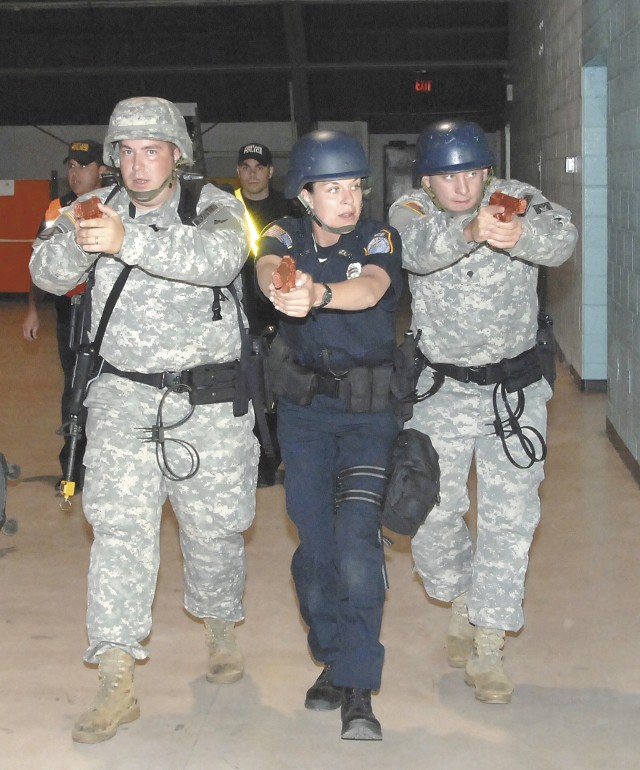Fort Lee, Va. (May 14, 2008) -- In light of the tragedies at Virginia Tech in 2007 and Columbine High School in 1999, patrol officers at Fort Lee are no longer relying on specialized teams to eliminate an active threat.
Conventional police officers are also training to respond to shootings and mass casualties when seconds make the difference between life and death. Individuals on each of the "watches" have been selected to train for specialized skills who will, in turn, train others.
During a simulated exercise May 6, members of the Fort Lee police department tested their training against a gunman suspected of killing people at a ceremony in the Post Field House.
"Their sole purpose is to eliminate the threat," said Police Lt. Dan Bateman, watch commander. "They are trained to go inside where they hear gunshots and to move deliberately toward the shots to eliminate the threat."
If the gunman was barricaded and held a hostage, the officers would implement different tactics. In this exercise, the patrol officers assumed an active shooter and did not wait for a Special Weapons and Tactics team to control the situation.
"Massive killings are going on, and you don't want any more people getting killed," said Police Officer Courtney Varner, Fort Lee police.
Response time for a SWAT or special reactionary team can take longer than required in some situations and police units must have an additional plan in the case of an active shooter, Bateman said.
"Traditionally, law enforcement (agents) in the past would set up a perimeter and contain the shooter and wait for SWAT to show up," Bateman said. "Now the new techniques have been developed, and we've implemented them because people are losing their lives. The officers that are on the road have to be trained to execute these tactics and to take out the active shooter. They don't have time to wait on SWAT."
Patrol officers are becoming proficient in breaching and movement techniques that were previously delegated to specialized teams like SWAT. Yet, the exercise only represented a low level of intensity, otherwise known as the crawl of a "crawl, walk and run" method.
Varner, a former special reaction team member, has been training other patrol officers on these active shooter situation tactics. He knew that day they would be tested with a simulated exercise, but it was challenging enough to realize how stamina plays a factor.
"When your adrenaline is going, it's like running two miles in 30 seconds. As soon as you come down from your adrenaline your whole body just gets exhausted," he said.
In addition to clearing a building, patrol officers have to evacuate the wounded, communicate with medics, and hold people running out because they are witnesses.
Police Officer Melissa Finborg, a selected trainee, said that one of the fundamental differences from her normal operation is that she goes into the hazardous situation instead of calling on a SWAT or SRT.
"Even though you know it's (an exercise), your adrenaline is still going and you're trying to rely on your training because you hope you don't make a mistake," she said.
The event, she said, was a good opportunity to see what she still needs to work on.
"This (exercise) was just the beginning, it's going to get harder, to the point where (the patrol officers) won't know it's coming," Varner said. "This time they got a heads up."


Social Sharing